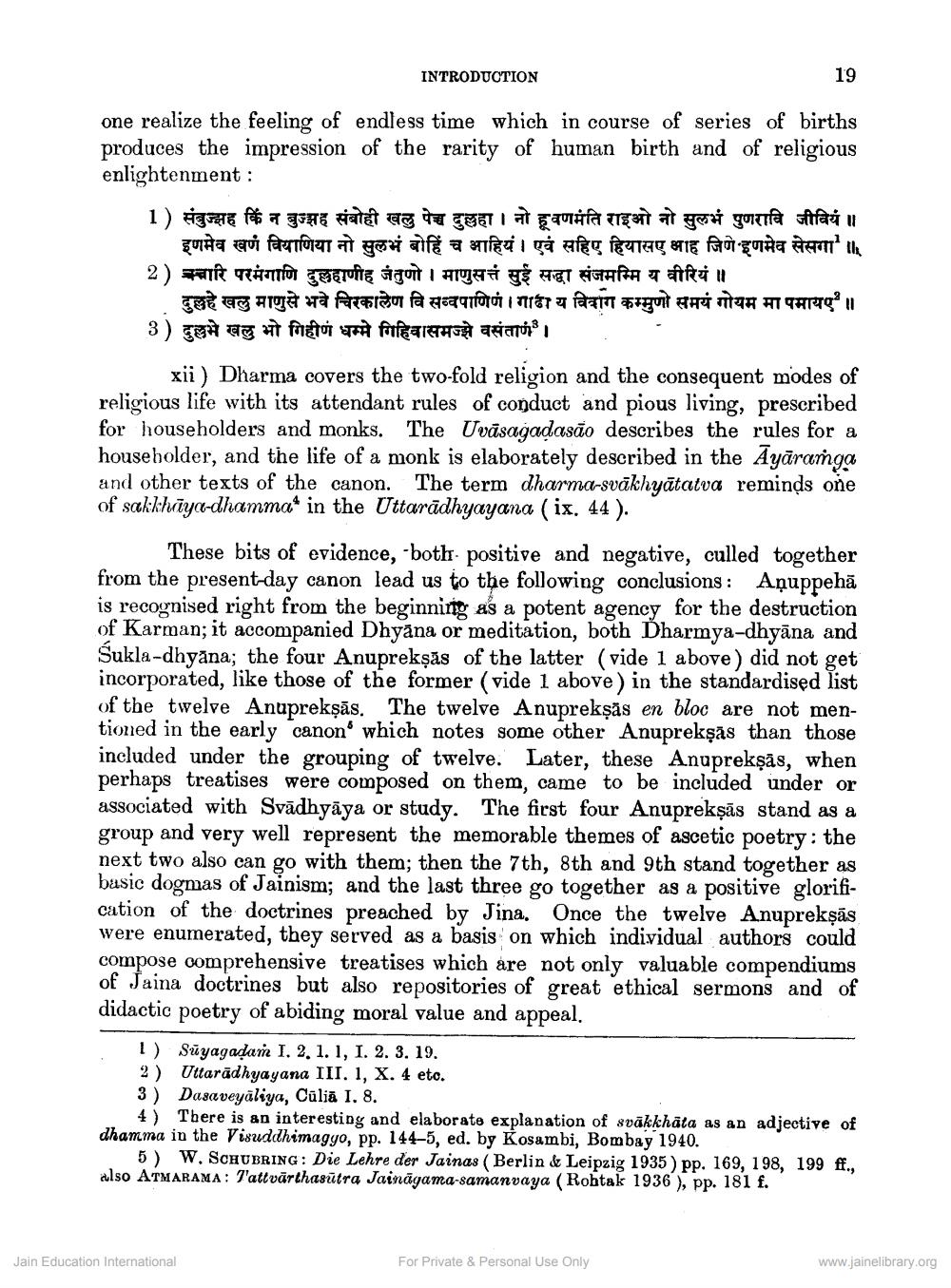________________
INTRODUCTION
one realize the feeling of endless time which in course of series of births produces the impression of the rarity of human birth and of religious enlightenment:
1 ) संबुज्झह किं न बुज्झह संबोही खलु पेच्च दुलहा । नो हूवणमंति राइओ नो सुलभं पुणरावि जीवियं ॥ इणमेव खणं वियाणिया नो सुलभं बोहिं च आहियं । एवं सहिए हियासए आह जिणे इणमेव से सगा ॥ (2) वारि परमंगाणि दुल्लहाणीह जंतुणो । माणुसत्तं सुई सद्धा संजमम्मि य वीरियं ॥
दुल्ल खलु माणुसे भवे चिरकालेण वि सव्वपाणिणं । गाढा य वित्राग कम्मुणो समयं गोयम मा पमायए ॥ 3) दुल्लभे खलु भो गिहीणं धम्मे गिहिवासमज्झे वसंता ।
19
xii) Dharma covers the two-fold religion and the consequent modes of religious life with its attendant rules of conduct and pious living, prescribed for householders and monks. The Uvasagaḍasão describes the rules for a householder, and the life of a monk is elaborately described in the Дyaramga and other texts of the canon. The term dharma-svākhyātatva reminds one of sakkhaya-dhamma in the Uttaradhyayana (ix. 44).
These bits of evidence, both positive and negative, culled together from the present-day canon lead us to the following conclusions: Anuppehā is recognised right from the beginning as a potent agency for the destruction of Karman; it accompanied Dhyana or meditation, both Dharmya-dhyāna and Sukla-dhyana; the four Anuprekṣas of the latter (vide 1 above) did not get incorporated, like those of the former (vide 1 above) in the standardised list of the twelve Anuprekṣās. The twelve Anuprekṣas en bloc are not mentioned in the early canon' which notes some other Anuprekṣas than those included under the grouping of twelve. Later, these Anuprekṣās, when perhaps treatises were composed on them, came to be included under or associated with Svadhyaya or study. The first four Anuprekṣās stand as a group and very well represent the memorable themes of ascetic poetry: the next two also can go with them; then the 7th, 8th and 9th stand together as basic dogmas of Jainism; and the last three go together as a positive glorification of the doctrines preached by Jina. Once the twelve Anuprekṣās were enumerated, they served as a basis on which individual authors could compose comprehensive treatises which are not only valuable compendiums of Jaina doctrines but also repositories of great ethical sermons and of didactic poetry of abiding moral value and appeal.
1) Suyagaḍam I. 2. 1. 1, 1. 2. 3. 19.
2) Uttaradhyayana III. 1, X. 4 etc.
3) Dasaveyāliya, Cūliā I. 8.
4) There is an interesting and elaborate explanation of svakkhata as an adjective of dhamma in the Visuddhimaggo, pp. 144-5, ed. by Kosambi, Bombay 1940.
Jain Education International
5) W. SCHUBRING: Die Lehre der Jainas (Berlin & Leipzig 1935) pp. 169, 198, 199 ff., also ATMARAMA: Tattvärthasutra Jainagama-samanvaya (Rohtak 1936), pp. 181 f.
For Private & Personal Use Only
www.jainelibrary.org




